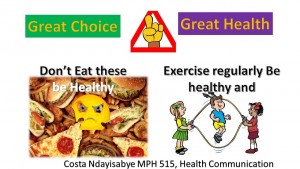Obesity among adolescents
Health communication is referred to the use of communication strategies to influence individuals’ behaviors toward the to improve health whereas social marketing is the use of marketing strategies to promote social change (The Community Guide, 2014). Both social marketing and health communication target behavior change persuasion through systematic strategies (Marketing and Communication).
The health issue I chose is the “Obesity among adolescents”. Obesity is defined as excessive body fat and considered risk factor of various diseases. According to CDC obesity has more quadrupled among adolescents. The percentage of adolescents with obesity aged 12-19 years has increased from 5% to nearly 21% between 1980 and 2012 (2015). There is a significant demographic difference among adolescents with obesity. For example children from Mexican or Africa-American families are more likely to be obese comparing to those from White families (Bishop, Middendorf, Babin & Tilson, 2005).
The soaring rate of obesity among adolescents is mostly caused by behaviors related to poor unhealthy diet or low physical exercises that can help to burn excess fat in the body. Obesity, therefore, can be prevented with the adoption of protective health behaviors. Social marketing and health communication are important tools to “put forth great effort to raise awareness, change attitudes, and teach skills related to engaging in healthy behaviors” (Crosby, DiClemente and Salazar, 2013).
In order to intervene to the obesity among adolescents it is important to primarily target parents or guardians. After the identification of obese adolescents, public health practitioners should craft plans that will promote education to parents or guardians on approaches to reduce the overweight children to a healthy weight. On of the approach is to educate a community who shares common interest such as same language or culture.
Communicating risks related to poor diet and physical inactivity is very important when educating on obesity. Designing the context of message distribution is very important step to consider in health communication planning.
Product: The product is the promotion of healthy diet and physical exercises among adolescents. The message will provide images and words that encourage children to go for health choices.
Price: Health communicators should ensure they have sufficient funds to sustain their programs and successfully achieve their major goal, to promote social change. Fund availability can help to push back competitors’ influences. I will ensure there is enough money to produce more good quality brochures. I will prove children with obesity necessary materials that support the new behavior adoption without they spend money for it. The most important will be to show both parents and children on how, if they comply with the message, children will be happy and active playing with others, no risks to be at the hospital regularly.
Place: To ensure an effective communication of the message I would work with the local schools, churches, football event organizers to distribute promote the campaign against obesity among the adolescents.
Promotion: Social marketing is very important to eradicate obesity among adolescents. Dealing with this health issue at a societal level will bring a good judgement between the benefits and risks of the behavior. For example, I would work with the schools to provide encouragement to the kids to have more salads on their plates.
Among the homework provided to children, there could be involved a physical activity homework such as jumping rope for 10 minutes daily. The child will be asked to encourage the parents to pair with him or her for the jumping rope exercise. The parents can supervise the child and sign on the paper if the child completed the assigned physical exercise.
Most of the time, public health programs tend to be on short period. This can cause relapse in individual’s change progress. To ensure the obesity is significantly reduced the health communication programs should be repetitive to reinforce the impact of the campaign’s goal (Crosby, DiClemente and Salazar, 2013). However, this can be costly especially due to the lack of strong support from funders.
References
Bishop, J., Middendorf, R., Babin, T., & Tilson, W., (2005). Childhood obesity.
Retrieved from http://aspe.hhs.gov/basic-report/aspe-childhood-obesity-white-paper.
Centers for Disease Control and Prevention (2015). Childhood obesity facts. Retrieved from http://www.cdc.gov/healthyschools/obesity/facts.htm
DiClemente, R.J., Salazar, L.F., & Crosby, R. A. (2013). Chapter 6: Stage models for health promotion. In Health Behavior Theory for Public Health. Burlington, MA. Jones & Bartlett.
The Community Guide (2014). Health communication and social marketing. Retrieved from http://www.thecommunityguide.org/ healthcommunication/index.html

